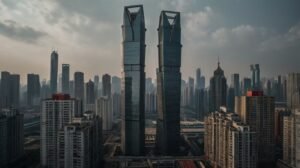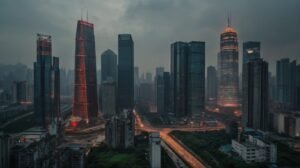
Introduction
As China stands at a critical juncture in its economic trajectory, the question of whether it will rebound from its current challenges or succumb to a prolonged slowdown looms large. The world’s second-largest economy is grappling with a myriad of internal economic struggles and external geopolitical tensions that threaten its stability and growth. This article will delve into the status of China’s real estate crisis and local government debt, youth unemployment, the tech and chip war with the United States, global manufacturing shifts, the Belt and Road Initiative, trade routes, and naval influence in the South China Sea. We will also explore how these factors intertwine to shape the future of China’s economy, humanizing the narrative to reflect the lives of ordinary citizens affected by these economic dynamics.
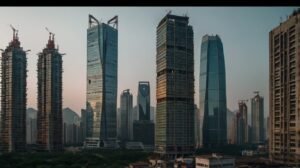
The Real Estate Crisis: A Ticking Time Bomb
Background
China’s real estate sector has been a significant driver of economic growth, accounting for a substantial portion of the nation’s GDP. However, in recent years, this once-booming industry has faced severe challenges, leading to a crisis that threatens not only the economy but also the financial stability of many families. With local governments heavily reliant on land sales for revenue, the collapse of property developers like Evergrande has raised alarms about the potential fallout.
The real estate boom in China began in the early 2000s, fueled by rapid urbanization, government policies that encouraged homeownership, and an influx of investment capital. Cities expanded rapidly, and property values soared, creating a perception of an ever-growing market. However, this growth was unsustainable, leading to overbuilding and a bubble that is now bursting.
Local Government Debt
Local government debt has reached staggering levels, largely fueled by the financing of infrastructure projects and the reliance on land sales. As the real estate market falters, local governments are struggling to meet their debt obligations, raising concerns about defaults and potential bankruptcies. This situation creates a ripple effect, impacting public services and infrastructure development across the country.
In recent years, local governments have turned to financial vehicles, such as Local Government Financing Vehicles (LGFVs), to raise funds for infrastructure projects. However, with the downturn in the real estate market, their ability to repay these debts has come under scrutiny. Many local governments are now facing fiscal deficits, leading to cuts in essential services and infrastructure maintenance.
Human Impact
The human cost of the real estate crisis is profound. Many families who invested their life savings in properties are now facing uncertainty and anxiety about their financial future. The fear of losing their homes has led to a growing sense of frustration among citizens, who feel that their aspirations for a better life have been jeopardized by the mismanagement of the real estate sector.
For example, the story of a family in Beijing who purchased their first home as an investment for their children’s future illustrates the widespread anxiety. As property values plummeted, they found themselves trapped in a mortgage they could no longer afford, leading to sleepless nights and constant worry about their financial stability. Similarly, a family in Xi’an, who had planned to use their home as a retirement nest egg, is now struggling to make ends meet.
Consumer Confidence
Consumer confidence has become a critical issue in the wake of the real estate crisis. With rising uncertainty and financial strain, many citizens are hesitant to spend, leading to a slowdown in domestic consumption. As consumer spending accounts for a significant portion of China’s economic growth, this decline poses a serious threat to the overall economy.
To restore consumer confidence, the government must implement policies that address the concerns of ordinary citizens. This includes providing financial assistance to those affected by the real estate crisis, increasing transparency in the housing market, and fostering a sense of stability in the economy.
Government Measures
In response to the crisis, the Chinese government has taken steps to stabilize the real estate market. Measures such as easing mortgage restrictions, reducing interest rates, and providing financial support to struggling developers have been implemented. However, these solutions have met with mixed results, as the underlying issues of overleveraging and lack of demand remain.
Furthermore, the government has initiated campaigns to encourage local consumption, aiming to bolster the economy by shifting reliance away from real estate. Programs promoting “staycation” tourism and local shopping are designed to rejuvenate markets that have suffered due to decreased consumer spending.
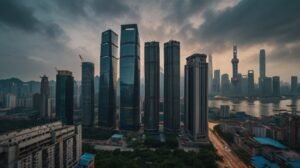
Youth Unemployment: A Generation at Risk
The Growing Challenge
As China’s economy grapples with structural shifts, youth unemployment has emerged as a pressing concern. With millions of young graduates entering the job market each year, the struggle to secure employment has become a stark reality for many. The COVID-19 pandemic exacerbated this issue, leading to layoffs and hiring freezes across various sectors.
According to recent statistics, youth unemployment in China has reached record highs, with many young adults unable to find jobs that match their qualifications. This situation poses not only an economic challenge but also a social one, as disillusioned youth may become increasingly frustrated with the system.
The Impact on Aspirations
Unemployment among young people not only affects their immediate financial stability but also has long-term implications for their aspirations and mental well-being. Many young adults find themselves at a crossroads, questioning their career paths and prospects. The pressure to succeed in a highly competitive job market can lead to feelings of inadequacy and anxiety, impacting their overall quality of life.
For instance, a young woman who graduated from a prestigious university with high hopes of joining a leading tech company found herself working part-time in a café due to the lack of job opportunities in her field. This experience not only affected her financially but also took a toll on her self-esteem and outlook on the future.
Government Response
The Chinese government has recognized the urgent need to address youth unemployment and has implemented various measures to promote job creation. Initiatives aimed at fostering entrepreneurship, increasing vocational training opportunities, and incentivizing businesses to hire young workers are essential for combating this growing challenge.
However, restoring confidence among young people requires more than just policy initiatives; it necessitates a cultural shift that values diverse career paths and acknowledges the challenges faced by the younger generation. Encouraging mentorship programs and creating networks for young professionals can help bridge the gap between education and employment.
Case Studies of Young Professionals
To illustrate the diverse experiences of youth in China, we can look at individual stories:
1. **Li Wei, a Graduating Engineer**: After graduating with a degree in engineering, Li Wei faced fierce competition for jobs in his field. Despite applying to numerous positions, he struggled to secure a role that matched his qualifications. Instead, he took a temporary job in an unrelated sector, feeling disheartened but determined to keep searching for opportunities in engineering.
2. **Zhang Hong, an Aspiring Entrepreneur**: Zhang Hong decided to take matters into her own hands by starting a small business selling handmade crafts online. While the initial response was positive, she faced challenges in marketing her products and managing finances. Yet, her determination to succeed kept her motivated, and she sought out online courses to improve her business skills.
3. **Wang Jun, a Vocational Training Graduate**: After struggling in the traditional academic system, Wang Jun enrolled in a vocational training program. He learned skills in plumbing and electrical work, which led to immediate job offers upon graduation. His story highlights the success of vocational education in addressing youth unemployment.
These narratives underscore the diversity of experiences among China’s youth and the importance of tailored support systems to help them navigate their unique challenges.
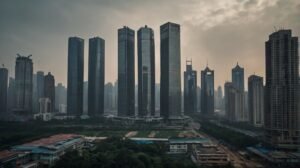
The Tech and Chip War with the U.S.: A New Battleground
Rising Tensions
The ongoing tech and chip war between China and the United States has significant implications for China’s economic future. As the U.S. imposes restrictions on semiconductor technology exports to China, the nation finds itself at a crossroads. The semiconductor industry is critical for technological advancements, and any disruptions in access can hinder China’s ambitions to become a global leader in innovation.
The U.S. government has imposed several rounds of sanctions targeting Chinese tech firms, particularly those involved in semiconductor manufacturing, citing national security concerns. This has led to a race for technological self-sufficiency within China as the government seeks to reduce dependence on foreign technology.
Domestic Efforts
In response to these challenges, China has ramped up its efforts to develop its semiconductor industry. The government has invested heavily in research and development, aiming to achieve self-sufficiency in chip production. However, the road ahead is fraught with obstacles, as the country must navigate complex technological landscapes and compete with established players in the industry.
The push for domestic chip production is not just about economic self-sufficiency; it also reflects national security concerns. The desire to reduce reliance on foreign technology has led to increased investment in education and training programs aimed at cultivating a skilled workforce in semiconductor engineering.
Human Impact
The ramifications of the tech and chip war extend beyond corporate boardrooms. For ordinary citizens, this struggle translates into potential job losses in sectors reliant on technology and innovation. As companies adapt to new realities, workers may find themselves facing uncertainty in their employment prospects.
To mitigate the impact on citizens, it is crucial for the government to invest in workforce retraining programs and support for affected industries. By fostering an environment that encourages innovation and adaptability, China can empower its workforce to thrive in a rapidly changing technological landscape.
For example, a factory worker previously engaged in manufacturing components for imported technology now faces the challenge of adapting to new roles in domestic chip production. With the right training and support, workers like him can transition into high-demand positions within the evolving tech industry.

The Role of Innovation
Innovation plays a critical role in China’s response to the tech and chip war. The government has launched initiatives to foster research and development in various technology sectors, including artificial intelligence, telecommunications, and renewable energy. By investing in these areas, China aims to create a more resilient economy that can withstand external pressures.
Startups and tech firms are also stepping up to meet the challenge. Entrepreneurs are exploring new technologies and business models that can thrive in a rapidly changing market. For instance, some companies are focusing on developing alternative materials for semiconductors or exploring new manufacturing techniques that reduce reliance on traditional supply chains.
Additionally, partnerships between universities and tech companies are being encouraged to foster innovation. Research institutions are collaborating with industry leaders to push the boundaries of technology, creating a dynamic ecosystem that can respond to both domestic and global challenges.
Global Manufacturing Shifts: The Rise of Competitors
Shifting Landscapes
As companies reevaluate their supply chains, global manufacturing is experiencing a significant shift. Nations like Vietnam, India, and Mexico are emerging as attractive alternatives to China for manufacturing due to their lower labor costs and favorable business environments. This shift poses both opportunities and challenges for China’s manufacturing sector.
The Impact on Chinese Manufacturers
For Chinese manufacturers, the rise of competitors presents a double-edged sword. While some companies may struggle to maintain their market share, others may find new opportunities to innovate and adapt to changing market demands. Embracing automation and advanced manufacturing techniques can help Chinese manufacturers remain competitive in the global landscape.
The competition may also spur a wave of innovation within China, as manufacturers are pushed to improve efficiency and quality. Companies that invest in research and development can find their niche in high-tech and specialized manufacturing, allowing them to thrive despite the shifting landscape.
Human Considerations
The transition in global manufacturing dynamics impacts workers across borders. While some may benefit from new opportunities in emerging economies, others may face job losses in established manufacturing hubs. It is essential to consider the human side of these shifts, as workers navigate the challenges of adaptation and retraining.
In response to these changes, China must focus on creating a workforce that is skilled in advanced manufacturing and technology. By investing in education and vocational training, the nation can equip its citizens to thrive in an evolving economic landscape.
For instance, a factory in Guangdong that once focused solely on low-cost consumer goods is now pivoting to produce high-tech components, requiring workers to upskill in new technologies. This transition not only helps the company remain competitive but also provides workers with better job security and prospects.
Case Study: Companies Adapting
1. **Huawei’s Shift**: Huawei has been proactive in adapting to the global manufacturing shifts by investing in research and development for its products. The company has diversified its supply chain and is looking into alternative markets for manufacturing components, which reflects a strategic response to the evolving landscape.
2. **Foxconn’s Expansion**: Foxconn, a major supplier for Apple, has expanded its operations in India and Vietnam, establishing new manufacturing facilities. This shift aims to hedge against potential disruptions in China and capitalize on the growing markets in Southeast Asia.
3. **Local Adaptations**: Smaller manufacturers in China are also adapting by focusing on niche markets, such as eco-friendly products or high-tech components. By innovating and catering to specific consumer demands, these companies can maintain competitiveness despite the challenges posed by shifting global dynamics.
4. **Government Support for Transition**: The Chinese government has also launched initiatives to support manufacturers in transitioning to higher value-added production. Financial incentives, tax breaks, and grants for technological upgrades are being offered to encourage innovation and efficiency.
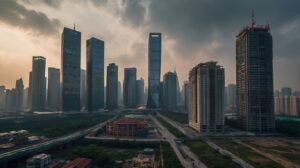
The Belt and Road Initiative: A Status Update
Overview
The Belt and Road Initiative (BRI) has been a cornerstone of China’s foreign policy and economic strategy. Launched in 2013, the initiative aims to enhance global trade and infrastructure connectivity by investing in projects across Asia, Europe, and Africa. However, the BRI faces challenges that impact its effectiveness and perception on the global stage.
Project Status and Challenges
As of now, several BRI projects have stalled or faced setbacks due to political tensions, financial constraints, and changing priorities among partner countries. The COVID-19 pandemic further complicated the situation, leading to delays and reevaluations of existing agreements.
The perception of the BRI has also evolved, with some countries expressing concerns over debt sustainability and potential dependency on China. The challenge for China now is to address these concerns while maintaining its influence and fostering mutually beneficial partnerships.
Humanizing the Narrative
For communities impacted by BRI projects, the initiative represents both opportunity and uncertainty. While infrastructure development can stimulate economic growth and improve living standards, it can also lead to displacement and environmental degradation. Striking a balance between development and social responsibility is vital for ensuring that the benefits of the BRI are equitably distributed.
Communities that see improvements in transportation and connectivity can experience economic revitalization, but they may also face challenges related to environmental sustainability and cultural preservation. Engaging with local populations and considering their needs can enhance the positive outcomes of BRI projects.
Future Prospects
Looking ahead, the BRI must adapt to changing global dynamics and address concerns about transparency and sustainability. By prioritizing community engagement, environmental considerations, and equitable partnerships, China can enhance the impact of the initiative and foster goodwill among partner countries.
Case Studies of BRI Projects
1. **Gwadar Port in Pakistan**: This project has the potential to transform the local economy, providing jobs and improving infrastructure. However, it has also faced criticism for displacing local communities and raising concerns about environmental impact.
2. **Railway Projects in East Africa**: Various railway projects funded by the BRI have improved connectivity in regions like Kenya and Ethiopia. While these projects promise economic growth, they have also raised questions about debt sustainability and long-term benefits for local populations.
3. **Investments in Renewable Energy**: Some BRI projects focus on renewable energy development, aiming to create sustainable infrastructure. By investing in green projects, China can address global climate concerns while enhancing its reputation on the international stage.
4. **Cultural Exchange Initiatives**: Alongside infrastructure projects, the BRI has also focused on cultural exchange initiatives that promote understanding and cooperation between China and partner countries. These efforts are aimed at fostering goodwill and long-term relationships.

Trade Routes and Naval Influence in the South China Sea
Strategic Importance
The South China Sea is a vital trade route, with a significant portion of global maritime trade passing through its waters. China’s growing naval influence in the region has raised concerns among neighboring countries and the international community. Control over these trade routes not only impacts commerce but also plays a crucial role in national security and geopolitical power dynamics.
Tensions and Conflicts
Competing territorial claims in the South China Sea have led to heightened tensions between China and its neighbors, including Vietnam, the Philippines, and Malaysia. The presence of military installations and naval patrols has further complicated these dynamics, raising fears of potential conflicts.
Humanizing the Impact
For coastal communities that rely on fishing and maritime trade, geopolitical tensions can have dire consequences. Fishermen may find their livelihoods threatened by territorial disputes, and local economies may suffer as a result. It is essential to consider the human impact of these geopolitical struggles and prioritize diplomatic solutions that promote peace and stability.
For instance, a fisherman from Hainan Island may find his fishing grounds encroached upon by tensions in the region, leading to economic hardship for his family. The need for dialogue and cooperation is paramount to ensure that the lives of ordinary citizens are not adversely affected by geopolitical disputes.
Navigating the Future
To address the complexities of the South China Sea, dialogue and cooperation between nations are essential. Collaborative initiatives focused on sustainable resource management and conflict resolution can pave the way for a more stable regional environment. By fostering trust and understanding, countries can work together to navigate the challenges of an interconnected world.
The Role of International Organizations
International organizations, such as the Association of Southeast Asian Nations (ASEAN), play a crucial role in facilitating dialogue and conflict resolution in the South China Sea. By fostering cooperation and promoting multilateral discussions, these organizations can help mitigate tensions and promote a peaceful resolution to territorial disputes.
The Role of Social Media and Information Flow
The Digital Landscape
In today’s digital age, social media plays a crucial role in shaping public perception and discourse around economic and geopolitical issues. In China, the government maintains a tight grip on information flow, but citizens still find ways to express their opinions and share experiences through various online platforms.
Citizen Voices
Social media platforms allow ordinary citizens to voice their concerns and frustrations regarding economic challenges. From discussions about rising living costs to the struggles of finding employment, these platforms serve as a space for dialogue and community building.
The narrative shared by citizens on social media reflects the realities faced by many in China. These voices can influence public opinion and even impact government policies, as leaders become increasingly aware of the sentiments expressed online.
The Importance of Transparency
As China navigates its economic crossroads, fostering transparency and open communication is essential. By engaging with citizens and acknowledging their concerns, the government can build trust and create a more inclusive dialogue around economic policies.
Impact on Policy Making
The ability of ordinary citizens to express their opinions online has led to increased pressure on the government to respond to public concerns. Instances of public outcry over issues such as pollution, corruption, and economic inequality have prompted government officials to take action. This shift illustrates the growing importance of citizen engagement in shaping policy decisions.
Conclusion: The Path Ahead
As China grapples with a myriad of economic challenges and geopolitical tensions, the question of whether it will rebound or face a long-term slowdown remains uncertain. The interplay of the real estate crisis, youth unemployment, the tech and chip war, global manufacturing shifts, the Belt and Road Initiative, and naval influence in the South China Sea will shape the nation’s future.
To navigate this complex landscape, it is essential for policymakers to prioritize the needs of ordinary citizens. By implementing strategies that foster innovation, support job creation, and promote social equity, China can build a more resilient economy that benefits all its citizens.
As we explore the trajectory of China’s economy, it is crucial to humanize the narrative and recognize the lived experiences of individuals impacted by these economic dynamics. By fostering empathy and understanding, we can better appreciate the challenges and opportunities that lie ahead.
For more insights into global economic trends and their implications, visit zaroraterishta.com
Detailed FAQs for the Article
1. What are the key indicators showing a slowdown in China’s economy?
Several indicators, such as declining exports, slowing real estate investment, youth unemployment, and weak consumer confidence, suggest a prolonged slowdown.
2. Is China still the world’s second-largest economy?
Yes, China remains the second-largest economy globally by nominal GDP, but its growth trajectory is becoming less predictable amid structural and geopolitical challenges.
3. How has China’s property market contributed to economic instability?
The collapse of major developers like Evergrande and Country Garden triggered a credit crunch, reduced consumer wealth, and exposed local government debt issues.
4. What role do geopolitical tensions play in China’s economic uncertainty?
Ongoing tensions with the U.S., trade restrictions, and supply chain realignments have disrupted Chinese exports and foreign investment.
5. Can domestic consumption drive China’s next phase of growth?
The government is attempting to shift toward domestic consumption, but low consumer confidence and rising household debt hinder this transition.
6. How is the Chinese government responding to the economic slowdown?
China is introducing stimulus packages, interest rate cuts, and easing property policies. However, these measures have shown limited long-term impact so far.
7. What are the implications of a Chinese slowdown for global markets?
A weaker China impacts global trade, commodity prices, manufacturing demand, and could ripple into developing economies reliant on Chinese investment.
8. Could China experience a ‘Japan-like’ stagnation?
Yes, some economists compare China’s current trajectory to Japan’s 1990s stagnation due to similar debt, demographics, and real estate challenges.
9. What sectors in China show resilience despite the slowdown?
Sectors like green technology, electric vehicles (EVs), AI, and semiconductors still attract investment and are driving pockets of innovation.
10. Is a rebound still possible, or has China hit a structural wall?
A rebound is possible with deep reforms, but structural issues—aging population, debt, and global realignment—mean growth will likely remain slower than in the past.

